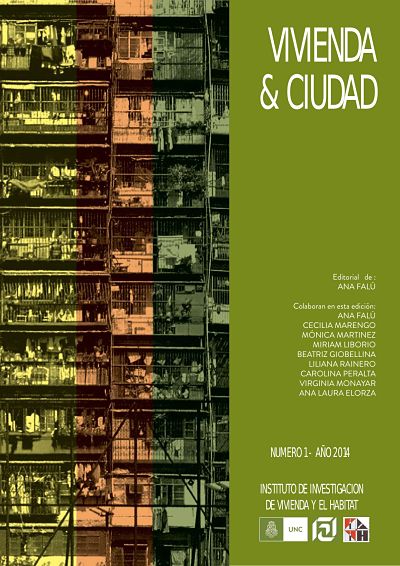El derecho de las mujeres a la ciudad. Espacios públicos sin discriminaciones y violencias
Keywords:
City rights, Violence, InequalityAbstract
Urban violence is a central theme of the agenda of governments and civil society. It seems that one factor that difficults the full “irruption” of women as citizens in the public sphere, are the growing violence in cities, and the ones that against women are exercised, which operate as a restriction of the rights of women to the city. The feminist theoretical contributions helped to understandhow relations of inequality between men and women are expressed in the different scales of territory, housing, neighborhood, the cities. Under the distinction made between public and private space are reinforced these asymmetries between men and women, being the body the first disputed territory to be recovered by women. Despite the progress conquered, the public spaces in cities, is still predominantly male. Under the considerations expressed, the article discusses the relationship between the right of women to the city, to a life free of violence, and local governments’ policies in this field. It interrogates as well on the differential impacts of such violence in the life of women and the obstacles that these pose in the exercise of their right to the city rights.
References
AMNISTÍA INTERNACIONAL (2003). Diez años de desapariciones y asesinatos de mujeres en
Ciudad Juárez y Chihuahua. Consultado en: www.amnestyusa.org.
BRAIG, Marianne. 2001. “Repensando los procesos de violencia en América Lati¬na. La
violencia sexualizada como violación de los derechos humanos.” En Violencia y
regulación de conflictos en América Latina, eds. Klaus Bodemer, Sabine Kurtenbach,
Klaus Meschkat, 25–38. Caracas: Nueva Sociedad.
CEPAL. ¡Ni una más! Del dicho al hecho: ¿Cuánto falta por recorrer? “Únete para poner fin a la
violencia contra las mujeres”; Octubre de 2009.
CISCSA- Red Mujer Y Hábitat de America Latina (2003). Indicadores Urbanos de Género.
2003. Córdoba: CICSA- Red Mujer y Hábitat.
DEL VALLE, Teresa. 2006. “Seguridad y convivencia: Hacia nuevas formas de tran¬sitar y de
habitar”. En Urbanismo y género. Una visión necesaria para todos. Barcelona: Ed.
Diputación de Barcelona.
FALÚ, Ana. 2009. “Violencias y discriminaciones en las ciudades”. En Falú Ana (editora).
Mujeres en la ciudad. De violencias y derechos. [Libro]. Santiago de Chile: UNIFEM,
Red Mujer y Hábitat de América Latina, Ediciones SUR, 2009; 1ª edición
FALÚ, Ana (2003). Gobernabilidad y ciudadanía. Dimensiones de la equidad den los gobiernos
locales. La Paz: Mimeo
FALÚ, Ana, (ed.). (2002). Ciudades para varones y mujeres. Herramientas para la acción.
Córdoba: Ediciones CISCSA – Red Mujer y Hábitat de América Latina, Ediciones SUR.
FALÚ, A. y RAINERO, L. (1994). Hábitat urbano: una visión de género. Córdoba: Ed. CICSA,
Red Mujer y Hábitat de América Latina.
FRASER, Nancy (1997). Justitia Interrupta. Reflexiones críticas desde la posición
postsocialista”. Santaféde Bogotá: Siglo del Hombre Editores, Universidad de los
Andes.
GALTUNG, Johan (1981). “The Specific Contribution of Peace Research to the Study of
Violence:Typologies”. En UNESCO, Violence and its Causes. Paris: United Nations
Education, Scientific and Cultural Organisation (UNESCO).
INDESO MUJER - Informe sobre feminicidios en Argentina. Consultado en
www.indesomujer.org.ar
LAGARDE, Marcela (2010) Los feminicidios son la punta del iceberg de todas las formas de
violencia cotidiana contra las mujeres. Consultado en: generoconclase.blogspot.com
MARTIN, K., VIERAITIS, L.M., BRITTO, S. (2006). “Gender Equality and Women’s Absolute
Status; A Test of the Feminist Models of Rape”. En: Violence Against Women 12(4):
321–336.
MONTEJO, A. F.; JIMÉNEZ SANDOVAL, R.; VILLANUEVA MONGE, Z. (2005) Justicia para las
mujeres:Un compromiso impostergable de los procesos de modernización del Estado.
San José: Fundación Justicia y Género.
MORO, Bruno (2008). “La seguridad humana: Una apuesta ética y política.” En: La seguridad:
un desafío permanente para Bogotá. Cuadernos del Informe de Desarrollo Humano
para Bogota no. 5. Bogotá: Programa para las Naciones Unidas para el Desarrollo
(PNUD).
PNUD – Programa de Naciones Unidas para el Desarrollo. (2006). El futuro de la movilidad en
Bogotá.Reflexiones a propósito del Plan Maestro de Movilidad. Cuaderno del Informe
de Desarrollo Humano para Bogotá, no. 1. Bogotá: Editorial El Malpensante.
RAINERO Liliana, (2009). “Ciudad, espacio público e inseguridad. Aportes para el debate
desde una perspectiva feminista”. En Falú Ana (ed.). Mujeres en la ciudad. De
violencias y derechos.Santiago de Chile: UNIFEM, Red Mujer y Hábitat de América
Latina, Ediciones SUR.
ROMÁN RIVAS, Marta. (2009). “Recuperar la confianza, recuperar la ciudad”, en Falú Ana (ed).
Mujeresen la ciudad. De violencias y derechos. Santiago de Chile: UNIFEM, Red Mujer
y Hábitat de América Latina, Ediciones SUR.
SEGATO, Rita Laura (2003). Las estructuras elementales de la violencia. Ensayos sobre
género entre la antropología, el psicoanálisis y los derechos humanos. Buenos Aires:
Universidad Nacional de Quilmes.
TORRES FALCÓN, Marta (2004). Violencia social y violencia de género. Ponencia Foro Las
Dignas –PNUD. El Salvador. Enwww.americalatinagenera.org/tematica/cvdpublicacion_
detalle.php?IDPublicacion=2.
UN - HABITAT – United Nations Human Settlements Programme (2008). State of the World’s
Cities2008/2009. Harmonious Cities. London: Earthscan.
VARGAS, Virginia (2009). “La violencia de género: pistas para su análisis.” En Falú Ana (ed).
Mujeres en la ciudad. De violencias y derechos. Santiago de Chile: UNIFEM, Red Mujer
y Hábitat de América Latina, Ediciones SUR.
Downloads
Issue
Section
License
Authors who publish in this journal agree to the following terms:
a. Authors retain copyright and guarantee to the journal the right to be the first publication of the work as well as licensed under a Creative Commons Attribution-ShareAlike 4 license.
b. Authors may separately establish additional agreements for non-exclusive distribution of the version of the work published in the journal (e.g., placing it in an institutional repository or publishing it in a book), with an acknowledgement of its initial publication in this journal.
c. Authors are permitted and encouraged to disseminate their work electronically (e.g., in institutional repositories or on their own website) before and during the submission process, as this may result in productive exchanges, as well as earlier and greater citation of published work (See The Effect of Open Access).
d. 4.0 International Creative Commons Attribution-ShareAlike 4.0 License.










